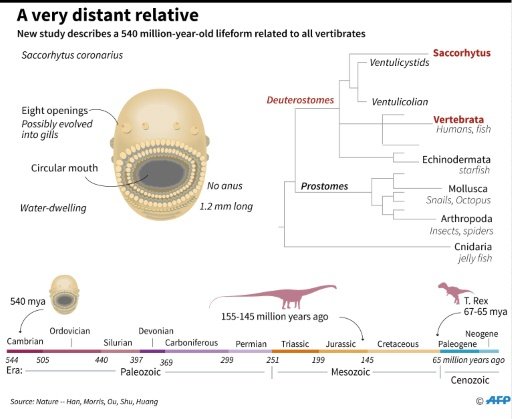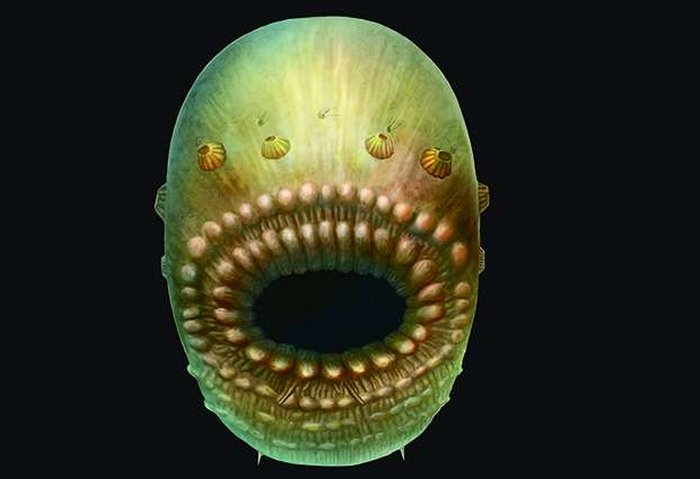Very Unusual Bag-Like Saccorhytus Coronarius Is Humans’ Oldest Ancestor
MessageToEagle.com – Saccorhytus Coronarius is a very unusual bag-like sea creature with a huge mouth and no anus. Scientists now say it’s humans’ oldest known ancestor.
Found in Shaanxi Province, in central China and named Saccorhytus, after the sack-like features created by its elliptical body and large mouth, this microscopic creature lived about 540 million years ago and it was the common ancestor of a huge range of species, including humans.
The Saccorhytus may represent “the primitive beginnings of a very diverse range of species, including ourselves,” Simon Conway Morris, Professor of Evolutionary Palaeobiology and a Fellow of St John’s College, University of Cambridge said.

According a to study published in the journal Nature “the bag-like body bears a prominent mouth and associated folds, and behind them up to four conical openings on either side of the body as well as possible sensory structures. An anus may have been absent, and correspondingly the later openings probably served to expel water and waste material.”
See also:
World’s Oldest Known Face Belongs To A 419-Million-Year-Old Fish
Our Ancestors Had A Tail And Lost It Twice
Our Jaw Evolved From Placodermi: A 423-Million-Year-Old Armored Fish
How Long Does Human Brain Develop?
By studying the minute fossils using an electron microscope and CT scanner, researchers were able to create a picture of what this creature may have looked like.

So this tiny sea-dwelling blob that may have pooped through its mouth.
In the early Cambrian period, the region would have been a shallow sea. Saccorhytus was so small that it probably lived in between individual grains of sediment on the sea bed.
It has previously been suggested that our jaw evolved from Placodermi – a 423-million-year-old armored fish.
MessageToEagle.com
Related Posts
-
 Unexplained Disappearance Of Kenny Veach And Mysterious M Cave In The Nevada Desert
No Comments | Jan 20, 2018
Unexplained Disappearance Of Kenny Veach And Mysterious M Cave In The Nevada Desert
No Comments | Jan 20, 2018 -
 Vredefort Crater Is The Largest And Oldest Impact Crater On Earth
No Comments | Jan 20, 2016
Vredefort Crater Is The Largest And Oldest Impact Crater On Earth
No Comments | Jan 20, 2016 -
 55 Cancri e – Most Exotic World We Can Only Imagine
No Comments | Feb 13, 2012
55 Cancri e – Most Exotic World We Can Only Imagine
No Comments | Feb 13, 2012 -
 Mysterious Artifacts: Glowing Black Pyramid With The Third Eye
No Comments | Sep 21, 2014
Mysterious Artifacts: Glowing Black Pyramid With The Third Eye
No Comments | Sep 21, 2014 -
 What Is The Human Genome And How Big Is It?
No Comments | Jan 31, 2016
What Is The Human Genome And How Big Is It?
No Comments | Jan 31, 2016 -
 Legendary Beowulf: Strong And Courageous Prince Of Geats Fighting Grendel And Dragon Monsters
No Comments | May 27, 2016
Legendary Beowulf: Strong And Courageous Prince Of Geats Fighting Grendel And Dragon Monsters
No Comments | May 27, 2016 -
 Ancient Egyptian Toys And Games In Focus
No Comments | Jan 15, 2016
Ancient Egyptian Toys And Games In Focus
No Comments | Jan 15, 2016 -
 Earth’s Core Is As Hot As The Surface Of The Sun
No Comments | Mar 14, 2016
Earth’s Core Is As Hot As The Surface Of The Sun
No Comments | Mar 14, 2016 -
 Bombay Blood Is One Of The World’s Rarest Blood Groups
No Comments | Mar 31, 2017
Bombay Blood Is One Of The World’s Rarest Blood Groups
No Comments | Mar 31, 2017 -
 All Hail Mimas: Our ‘Death Star’ Moon
No Comments | Dec 20, 2015
All Hail Mimas: Our ‘Death Star’ Moon
No Comments | Dec 20, 2015
